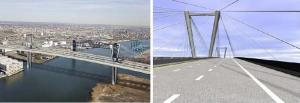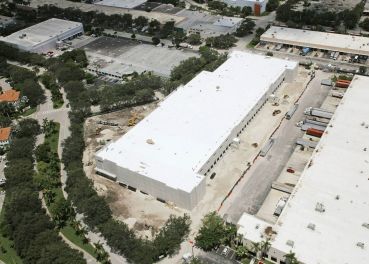 With a preliminary request for bidders sent out this week, the Port Authority of New York and New Jersey is headed down the road of privatization to help solve the woes of aging infrastructure, looking for a private company to take the lead on replacing the Goethals Bridge between Staten Island and New Jersey. The construction itself would cost $755 million based on a 2007 estimate, although the agency expects bids to come in well over $1 billion when other costs are factored in.
With a preliminary request for bidders sent out this week, the Port Authority of New York and New Jersey is headed down the road of privatization to help solve the woes of aging infrastructure, looking for a private company to take the lead on replacing the Goethals Bridge between Staten Island and New Jersey. The construction itself would cost $755 million based on a 2007 estimate, although the agency expects bids to come in well over $1 billion when other costs are factored in.
The driving concept: A private venture would design, build, finance and maintain a new bridge for 30 to 40 years, taking a fixed, set payment from the authority to be paid out over the length to the deal.
In the world of PPP (public-private partnership) fanatics, this would all be very rosy: The deal would save the Port Authority money up front by bringing private equity into the deal; the private sector would add all sorts of efficiencies that the public sector can’t realize on its own; and investors would take a comfortable return in the long run. In Europe, PPPs are common, and other states, Florida included, are starting to dabble in them with greater frequency, as droves of bankers line up at the doors of state capitols to pitch such ideas. (The Port Authority had a similar contract for the monorail at Newark Airport.)
And there is something to be said for the theory: The Port Authority has a reputation for being a rather difficult client (construction costs are considered far higher with the agency than in the private sector). And a private firm that would be responsible for building and maintaining a bridge has incentive not to do a shoddy job—any cables that break five years down the line would be fixed out of their pockets.
But the list of concerns with such an arrangement is a long one, and at least based on the info released thus far, it’s not clear it would be in the agency’s best interest (presumably, a lot will depend on how the bids come in).
For one, these deals are massively complex, and, as with any major government/private deal, there is a risk that a deal would collapse months or years into negotiations, sending the Port Authority back to the drawing board. The bistate agency, after all, is overseen by two governors with different election terms, and new governors can sharply shift policy at the agency when they come in.
For another, in the long term, this may well be more expensive for the agency than doing it itself. Equity investors, after all, want profit on their money, particularly if they’re taking really big risks (agreeing to a 40-year contract on a new bridge at a fixed price is a big risk), adding a premium on top of whatever construction and borrowing costs there are. The cost of borrowing may be much higher under a private scheme, and there would presumably be less tax-exempt financing available than if the Port Authority built the bridge itself.
The structure of these projects tends to be heavily reliant on details to see whether the partnerships are beneficial for the public, and the incentives are all aligned appropriately. In a simple example, while the nature of a 40-year contract (where the investor pays for repairs) would give incentive to the private investor to build a bridge that doesn’t fall apart in 20 or 35 years, the builder might have no qualms about building something that would fall apart at 41 years. Thus, it is also the authority’s role to structure and monitor a deal so that it considers these long-term concerns and other issues that affect the public good.
The Port Authority’s line on all of this is that it doesn’t have the ability (read: bond capacity) now to pay for a new bridge by itself, and thus it’s looking to a limited PPP, one that would have it still maintain control over the bridge.
“With infrastructure needs growing and public resources shrinking, the Port Authority should be a leader in the kind of innovative infrastructure development that will meet our region’s critical needs while protecting the public’s interest,” the Port Authority’s executive director, Chris Ward, said in a statement. “We believe this structure will get us there and we look forward to the market’s response to this first step.”
The timeline, which envisions a new bridge in 2016, calls for a series of solicitations of interest, with a bidder selected in the second half of 2011.


